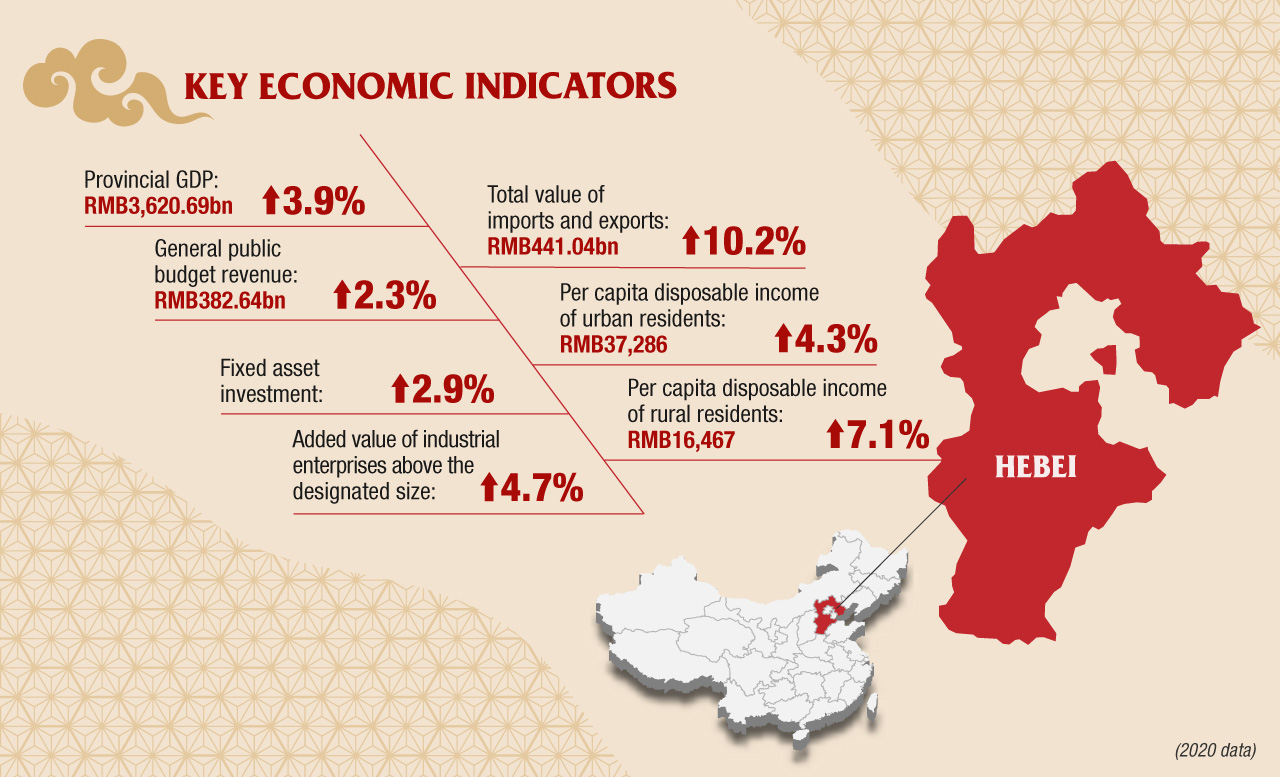Ideally located in the north of China, Hebei Province has immense opportunities for future development, which are beneficial to increasing the province’s competitive edge.
Hebei Province is situated in the coastal region of northern China and in close proximity with Beijing and Tianjin as it plays a key role in the Beijing region and its surrounding area. The province covers a total area of 188,000 square kilometres and has a coastline of 487 kilometres. It is the only province in the country to have shorelines, plains, lakes, hills, mountains and plateaus. Hebei administers 11 cities with districts, the Xiong’an New Area, two counties that are directly administered by the province and 167 counties (cities and districts). It has a total population of 75.9197 million.Rich history, culture and natural resources
Hebei is one of the birthplaces of the Chinese nation, with a history that can be traced back to more than 5,000 years. With Beijing being chosen as the capital of the country in the Yuan, Ming and Qing dynasties, the status of the province has become even more prominent.Hebei boasts a deep cultural heritage that underpins a distinctive tourism industry. It has a number of red tourist attractions such as the Xibaipo Memorial Hall and the former site of the 129th Division of the Eighth Route Army; green tourist attractions such as Saihanba National Forest Park and Bashang Grassland; white tourist attractions, which include ice and snow sporting activities in Chongli District of Zhangjiakou City; and Bohai Bay blue tourist attractions, which include Qinhuangdao, Tangshan and Cangzhou.
Its number of major historical and cultural sites protected at the national level ranks third in China, while it is at the forefront of the country at the provincial level. There are four UNESCO World Cultural Heritage Sites located in the province, namely the Chengde Mountain Resort and neighbouring temples, the Eastern and Western Qing tombs, the Great Wall and the Grand Canal. In addition, there are six national famous historical and cultural cities, 11 national 5A tourist attractions including Baiyangdian and Shanhai Pass and Jinshanling of the Great Wall, and 141 4A tourist attractions including Hengshui Lake and Thaiwoo Four Seasons Town in Chongli District.
Hebei is also a province of abundant agricultural resources with a sown area of 6.4692 million hectares. Its annual outputs of vegetables, meat, milk and eggs are top of the country. In addition to a forest coverage rate of 35 percent, the province is also rich in natural gas and has 158 types of minerals — including coal, iron and oil, 41 of which are among the top five in the country.
Advantageous location
Hebei is the hub of connecting the “Three Northern Regions” in eastern China, southern China and southwest China. It is a key node in the layout of the national radial highway and railway network and has a well-developed, comprehensive and modern transportation network which includes 7,981 kilometres of railways, 1,690 kilometres of high-speed railways, 7,809 kilometres of expressways and seven public airports (including Shijiazhuang Zhengding International Airport and Tangshan Sannvhe Airport). Beijing Daxing International Airport, which began operations on 25 September 2019, is only 55 kilometres away from the Xiong’an New Area. The province also has a port cargo throughput of 1.12 billion tons as it is home to three 100-million-ton ports (Qinhuangdao, Tangshan and Huanghua) that have already established trade relationship with more than 400 ports around the world.Steady economic growthm
In recent years, Hebei has built an increasingly close relationship with Beijing and Tianjin. The Xiong’an New Area is constructing in full swing . The province has already completed all 76 preparatory projects for the 2022 Beijing Winter Olympics. It is moving forward in an innovative, environmentally friendly and quality way. Steel production capacity has been reduced from 320 million tons to 199 million tons. The industrial structure of Hebei has changed as it now places more importance on tertiary industries (i.e. service industry), followed by secondary industries (industrial and construction) and primary industries (agriculture, forestry, animal husbandry, fishery), rather than in the order of secondary industries, tertiary industries and primary industries like in the past. The service industry has contributed to more than 60 percent of the province’s economic growth. For three consecutive years, Hebei has implemented 20 public projects annually that aim to enhance the livelihood of its citizens. Spending on improving people’s livelihood accounts for more than 80 percent of all public budget expenditures. Society has maintained harmonious and stable. Having achieved success in containing the COVID-19 pandemic, Hebei’s economic and social development withstood the impact brought by the pandemic to show signs of stability and improvement. Its key economic indicators in 2020 have all performed better than the national average.
Strategy of the co-ordinated development of the Beijing–Tianjin–Hebei Region
Thanks to being incorporated into the national strategy for the first time, Hebei is enjoying a golden opportunity for development together with Beijing and Tianjin, which marks a new era for the province. Based on the overall functional position of the Beijing–Tianjin–Hebei region, Hebei is strengthening four major functions of development: it is building a national modern pivotal base for trade and logistics, pilot sites for industrial transformation and upgrade, demonstration areas for a new type of urbanisation and overall urban–rural development, and supporting zones for the ecological environment in the Beijing–Tianjin–Hebei region.For the first time ever, Hebei, Beijing and Tianjin jointly formulated the Opinions on Strengthening the Construction of Key Platforms for Beijing and Tianjin’s Industrial Transfer to Hebei, preliminarily establishing the “2+4+46” industrial transfer platforms. The “2” refers to the two centralised transfer regions of the Beijing Sub-centre and the Xiong’an New Area. The “4” refers to the four big strategic co-operative functional regions of the Caofeidian Demonstration Area for Co-ordinated Development, the Beijing New Airport Economic Area, the Tianjin Binhai New Area and the Zhangjiakou–Chengde Ecological Function Area. Lastly, there are 46 specialised transfer platforms, 34 of which are located in Hebei.
High-speed development of the Xiong’an New Area
On 1 April 2017, Xinhua News Agency was authorised to announce that the CPC Central Committee and the State Council decided to establish the Xiong’an New Area, creating another district of national significance after the Shenzhen Special Economic Zone and Shanghai Pudong New District. The Xiong’an New Area and Beijing Sub-centre are helping the capital to develop further. The plan to build the Xiong’an New Area is of national importance and will have a lasting impact for generations to come.Hebei is creating the Xiong’an Quality and Xiong’an Standards which adhere to a global vision, follow international standards, feature Chinese characteristics and have a high position in mind. They will be integrated into every aspect and process of the development of the area. Through a concerted effort of the entire province, Hebei is building the area into an innovative, smart and environmentally friendly place, so that it will alleviate some of the “non-capital” functions of Beijing and establish itself as a demonstration area for innovation-driven development to act on the new development philosophy.
In 2018, the State Council approved The Outline Plan for Xiong’an New Area, Hebei, The Overall Plan for Xiong’an New Area, Hebei (2018–2035) and The Plan for Ecological Conservation and Environmental Protection of Baiyangdian Lake (2018–2035). With the establishment of the “1+N” planning system and the “1+N” policy system, Hebei is going full speed ahead with the development of the Xiong’an New Area.
Hosting snow sports events of the 2022 Winter Olympics
In July 2015, Beijing was selected to host the 2022 Winter Olympics, with some of the snow sports events to be held in Zhangjiakou City of Hebei. This will not only provide opportunities for just Zhangjiakou, but for the entire province to improve its infrastructure, optimise its industrial distribution and develop the tourism and sports industries. Hebei will make use of the opportunity of taking part in the Winter Olympics to improve the urban construction of Zhangbei Area of Zhangjiakou City, so that it will join hands with the Xiong’an New Area in becoming the “two wings” of Hebei.CCPIT Hebei Council (CCOIC Hebei) Profile
China Council for the Promotion of International Trade (CCPIT) Hebei Council (China Chamber of International Commerce (CCOIC) Hebei Chamber of Commerce) is a non-governmental organisation devoted to promoting international trade and economy. Comprised of businessmen, enterprises and communities in Hebei, it acts as the bridge of co-operation with international businesses and the link between enterprises and the government. The mission of the CCPIT Hebei Council is to develop co-operation between Hebei and other countries and regions in trade, investment, international operations of enterprises, economy and technology.For over 30 years, CCPIT Hebei Council has assisted the government to connect with overseas economic groups, helped enterprises explore international markets and provided support for foreign investment in Hebei by utilising all means and methods such as attending exhibitions, aiding with legal affairs, providing information and training through both domestic and international channels. At present, a working network at home and abroad has taken shape; branches of the organisation have been established in 11 cities and more than 60 counties in Hebei Province. CCPIT Hebei Council has developed friendly co-operation with 163 chambers of commerce, associations, economic organisations and enterprises covering 43 countries and regions. It has become the most influential promotional institution for foreign trade and investment in Hebei.

